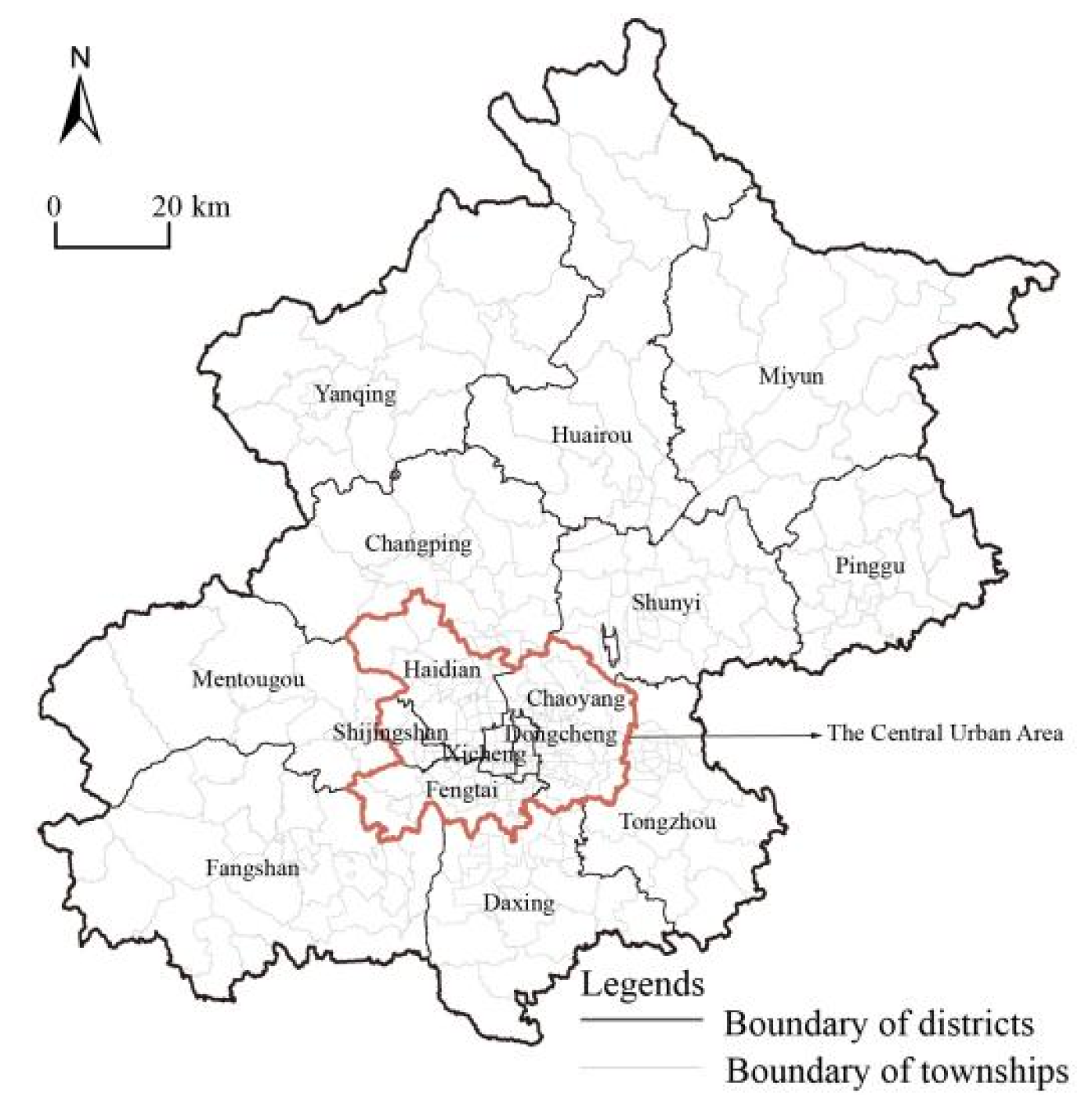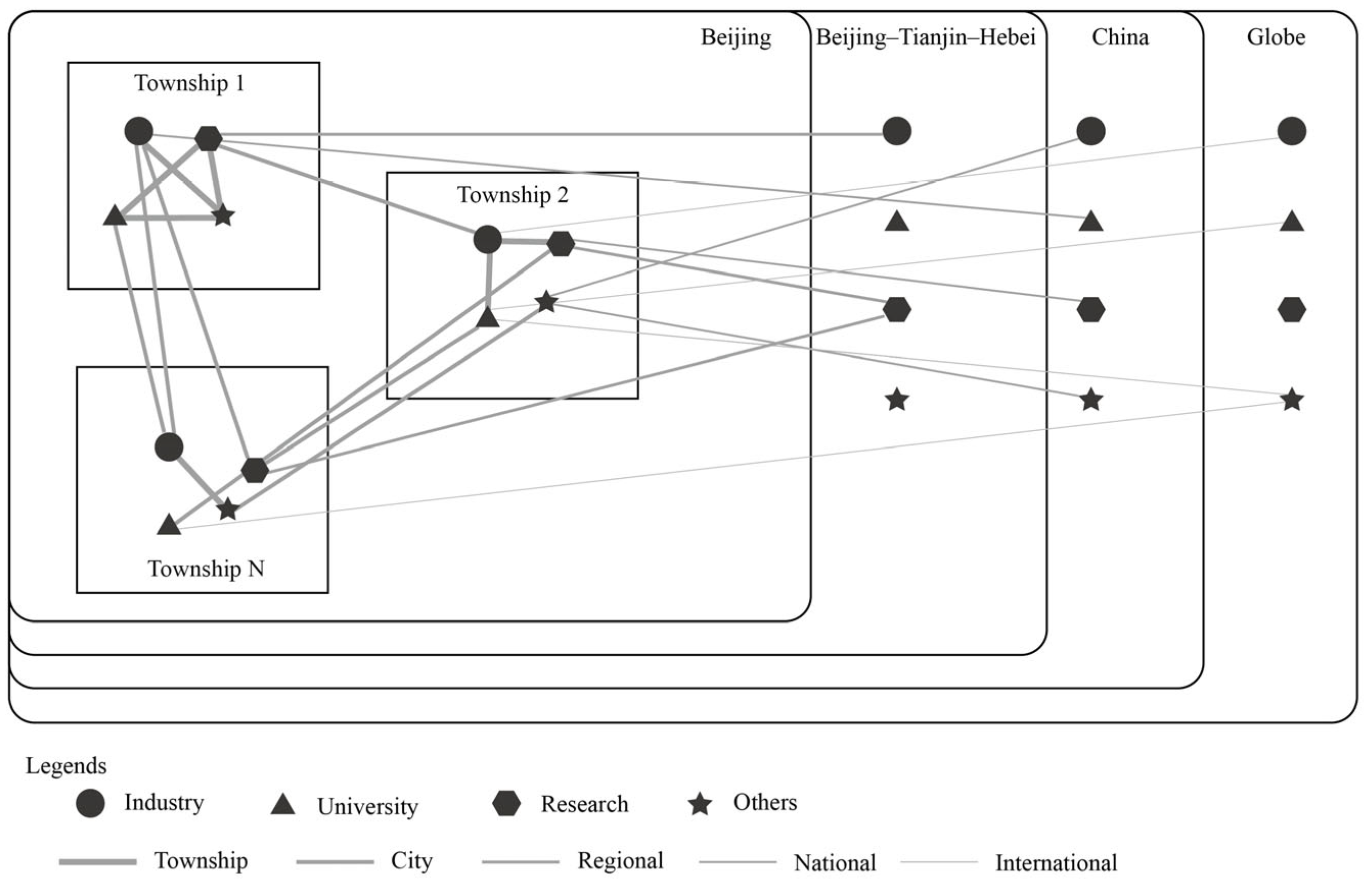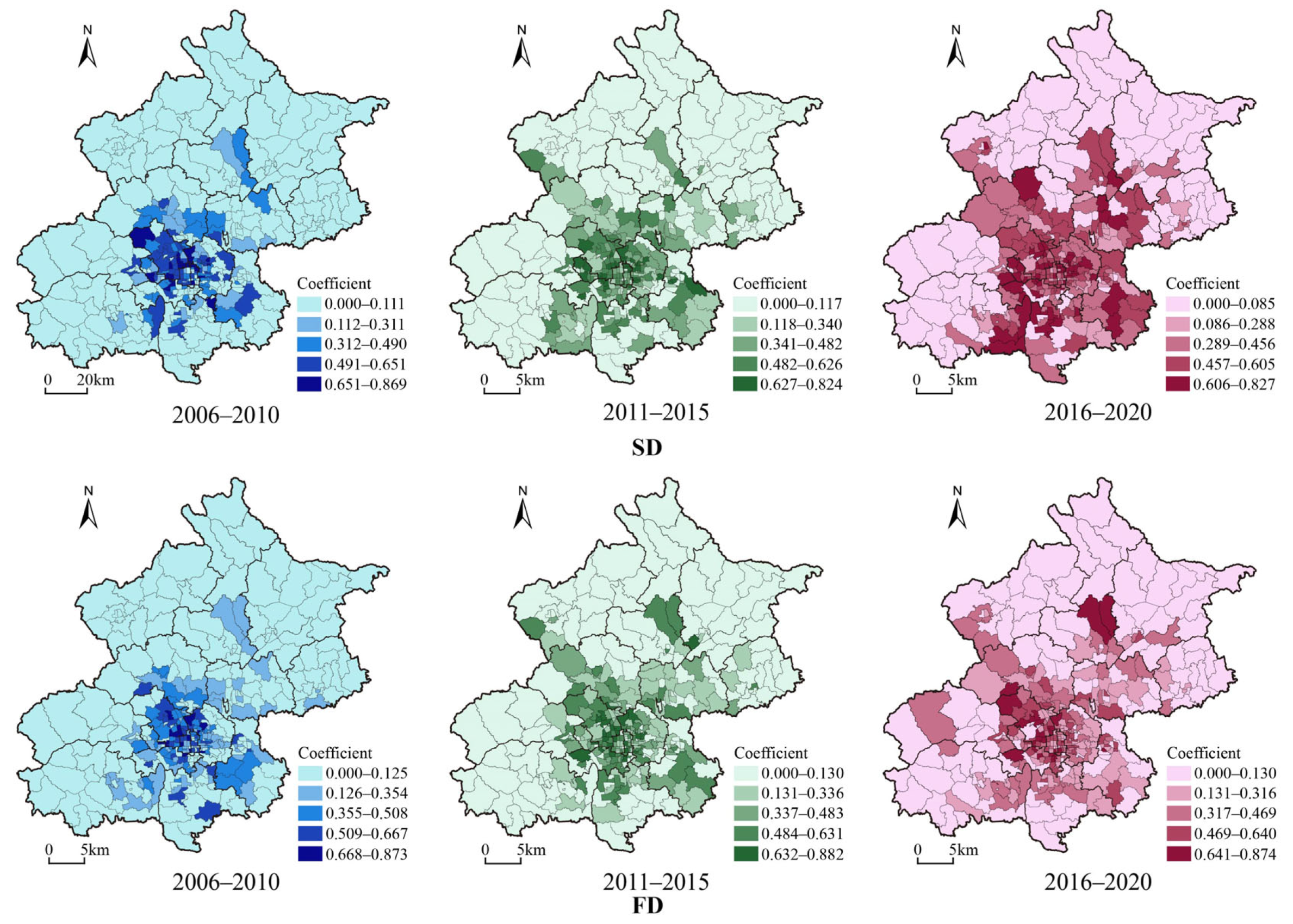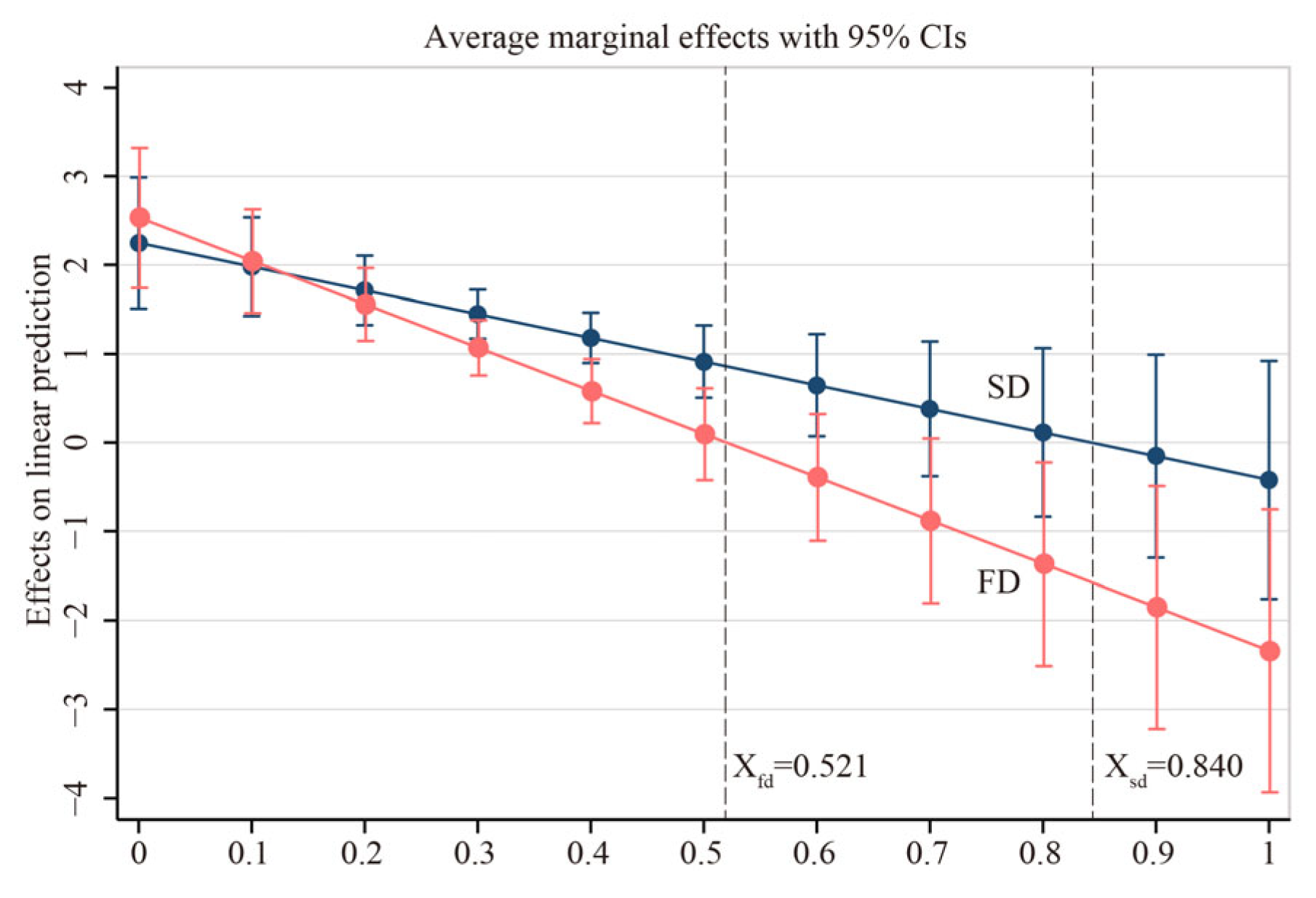1. Introduction
Factors fostering innovation constitute an interdisciplinary research agenda wherein diversity is a prominent theme [
1]. Recent studies have highlighted the role of diversity in promoting innovation. Fundamental to the ability of diversity to foster innovation is the ability to provide access to knowledge, resources, and technology, hence creating knowledge externalities [
2]. The knowledge base view (KBV) proposes the importance of knowledge for innovation participants. However, diversity challenges knowledge absorption and network management capabilities. Transaction cost theory, for example, states that innovators tend to favor lower costs. The study of knowledge diversity externalities originates mostly from research on Jacobs’ externalities. Jacobs posited that the most important source of knowledge spillovers comes from outside the industry in which the firm operates [
3]. Jacobs’ externalities refers to urbanization economies as one type of agglomeration economy [
4]. Her theory emphasizes that industry diversity within a geographic region promotes knowledge externalities and fosters innovative activity and economic growth [
5]. Beaudry and Schiffauerova summarize various types of Jacobs’ externalities measures [
6]: the Hirschman–Helfendahl Index (HHI), employment in other industries, the Gini coefficient, the total regional population, total regional employment, etc. The HHI is the most commonly used [
7]. Empirical evidence for Jacobs’ diversity remains an interesting topic.
Another category of the literature is network externalities [
8,
9,
10]. The rise of networks can be traced back to Castells’ proposal of ‘space of flows’ [
11]. He pointed out that the space of flows is the spatial logic of globalization, in which power and functioning derive from networked exchanges (capital, data, technology), rather than from fixed territories. In this context, access to networks becomes more important than the locational attributes of a particular place [
12]. Knowledge is a crucial component in the flow of innovation. Participants in innovation connect to suitable partners in order to access external knowledge. All participants and their inter-connections form a network. An innovation cooperation network (ICN) consists of network nodes, such as individuals, organizations, cities, regions, and countries, and network connections, such as co-invention relationships, joint R&D projects, or intellectual property transfer [
13]. Most previous studies have used different types of network nodes to confirm the close association between network structure and innovation performance [
14]. ICNs act as a crucial channel for acquiring varied knowledge externalities. The network’s facilitating role is regarded as network externalities [
10]. Scholars typically analyze the externalities of network structure with regard to regional innovation from the perspectives of network size, network heterogeneity, network centrality, and network bonding strength [
15,
16]. Limited research examines this topic through the lens of network heterogeneity, particularly relational heterogeneity [
15].
There exists a discourse concerning the association between agglomeration and network externalities, positing either no relationship [
15,
17], a complementary relationship [
18,
19], or a substitutive relationship [
20,
21]. Notwithstanding multiple pertinent studies, a consensus continues to be unattainable. In conclusion, the relationship between network and agglomeration externalities is still ambiguous, particularly at the intra-township level [
22]. Current research offers a solid foundation for examining the correlation between network diversity externalities, Jacobs’ externalities, and regional innovation. Nevertheless, the majority of studies concerning the externalities of ICNs predominantly emphasize network centrality and neglect network connection diversity. What is the impact of network diversity on local innovation capacity within a city, and how does functional diversity interact with scale diversity? The relationship between network and agglomeration externalities from a diversity standpoint requires elucidation.
It is essential to examine the structure of ICNs that influence local innovation. Empirical studies facilitate the advancement of local innovation in urban areas. Co-invention data are often chosen to depict ICN, due to the ease of access and well-organized characteristics of patent data [
23]. Collaborations among inventors form differentiated transfer functions in knowledge exchange [
24]. Under the trend of global innovation, patent cooperation is often cross-scale [
25] and cross-sector [
26], characterized by high diversity and heterogeneity. As a high-density international metropolis and a pivotal node in the global innovation network, Beijing has experienced rapid growth in co-invention relationships [
27], making it an ideal case for study. In the specific context of China, administrative boundaries often restrict the allocation and flow of innovative elements. Therefore, township-level administrative regions are better spatial divisions for studying uneven innovation within cities. This study utilizes 343 townships in Beijing from 2006 to 2020 as the research units. Utilizing multi-source data, spatial analysis, and a panel regression model, this study examines and elucidates the relationship between network diversity, network externalities, and local innovation to enhance the theoretical comprehension of network externalities.
The research objectives of this paper are as follows: (1) to identify the spatial distribution features of network diversity from scale and functional perspectives; (2) to use a panel negative binomial regression model to clarify the influence of scale and functional diversity, as well as their interaction, on local innovation capacity; and (3) to reveal the impact relationship between network diversity and Jacobs’ diversity on local innovation capacity.
The contributions of this paper mainly involve the following aspects: (1) The network diversity of the ICN is measured in both the scale and functional dimensions at the township level, which helps to understand the characteristics of network heterogeneity within cities and broadens the perception of network properties; (2) The nonlinear impact of ICN’s network diversity on local innovation is clarified, and the interaction effects between scale and function diversity are examined. These findings enrich the scholarship on network externalities; (3) The relationship between network externalities and Jacobs’ externalities, based on the diversity perspective, is further discussed. This result provides empirical evidence for the relevant academic debate.
The remainder of this paper is structured as follows:
Section 2 conducts theoretical analysis and proposes some hypotheses.
Section 3 describes this paper’s data, methods, and variables.
Section 4 describes the spatio-temporal evolution of network diversity.
Section 5 tests the proposed hypotheses using econometric methods. Finally, there is a conclusion and discussion.
5. Discussion
5.1. The Network Diversity Dynamic of the ICN in Beijing from 2010 to 2020
Since the 21st century, major mega-cities, including Beijing, have been deeply integrated into the global ICN. This paper reveals the spatio-temporal characteristics of network diversity at the township level in Beijing. The results show that from 2010 to 2020, the network diversity level of the ICN in various townships has increased significantly. Specifically, the average scale diversity level has risen by 84.946%, while the average functional diversity level has risen by 42.632%. The spatial distribution of both types of network diversity presents a core–periphery pattern. We measured the heterogeneity of network connections in the two dimensions, expanding our understanding of the network structure of the ICN. Our study extends and complements the ‘buzz-pipeline’ theory by showing differences in the roles of the ‘pipeline’ at different scales.
5.2. The Impact of Network Diversity on Local Innovation
This paper reveals the nonlinear impact of scale and functional diversity within innovation cooperation networks on local innovation. The formation of innovation is built upon a moderately complex level of knowledge combinations. Excessively complex knowledge sources can lead to overload. Whether in the scale or functional dimension, an excessively high level of network diversity increases the complexity of knowledge sources, making knowledge integration, absorption, and maintenance difficult. This is highly detrimental to local innovation. The marginal effect of network diversity on the innovation capacity of towns and villages first increases and then decreases, supporting hypothesis H1a, with an inverted U-shaped impact. This result is consistent with the findings of Wang et al.’s study [
90]. They explored the relationship between knowledge diversity and research performance in research collaborations, and found an inverted U-shaped pattern between interdisciplinary collaboration diversity and social impact. Some studies disagree. Wen et al. analyzed the positive effects of relevant and irrelevant network knowledge diversity on firms’ innovation outcomes [
71]. While realizing that growing relevant knowledge diversity still increases firms’ absorption pressure, they did not test the potential negative effects of network diversity. Compared to previous studies, we emphasize the threshold effect of network diversity and distinguish different dimensions of network diversity.
5.3. The Impact of the Interaction Between Scale and Functional Diversity on Local Innovation
This study indicates a substitutive relationship, rather than a complementary one, between scale and functional diversity. This is primarily because knowledge from different sectors and scales tends to be similar. The long-term acquisition of homogeneous knowledge can lead to cognitive lock-in, thus undermining the vitality of innovation [
60]. The case studies also show that industry-based townships often rely on scale diversity as a substitute for functional diversity, due to the relatively homogenous nature of local innovation players. High-level knowledge absorption capability integrating fragmented knowledge is a severe challenge for towns, particularly those in remote regions.
5.4. The Impact of the Interaction of Network Diversity and Jacobs’ Diversity on Local Innovation
The relationship between network externalities and agglomeration externalities is far from a consensus. We provide empirical support for the substitution relationship view. The regression results reveal the substitutive relationship between network and Jacobs’ diversity. However, stability tests indicate that this relationship is not stable. Models M6 and M7 in
Table 3,
Table 4 and
Table 5 indicate that the impact of the interaction is no longer significant. The research by Zhou et al. supports our conclusion [
84], but Capone et al. reached the opposite conclusion [
91]. Other studies indicate an insignificant interaction effect between the two [
63]. Existing studies have mostly measured agglomeration externalities from a specialization perspective, with less consideration given to the diversification perspective or the urbanization economy. We provide a perspective for understanding the alternative relationship between the network and Jacobs’ externalities regarding spillover effects. More empirical analysis is needed to unravel this complex relationship, considering other agglomeration mechanisms in the future.
5.5. Contributions and Limitations
This paper contributes to ICN research in three ways: (1) The analysis of network diversity enriches our understanding of the heterogeneity of network connections by considering both the scale and function of network connections. (2) The nonlinear impact of network diversity on innovation is investigated, and the threshold effect of network diversity is identified. Furthermore, the substitutive relationship between the two types of network diversity emphasizes the importance of the necessary trade-offs that townships must make when managing their networks. (3) The alternative relationship between network diversity and Jacobs’ diversity is revealed, providing valuable empirical evidence to elucidate the link between network externalities and agglomeration externalities from a knowledge spillover perspective. Additionally, this study operates at the township level, reflecting the uneven innovation dynamics within mega-cities more accurately.
However, there are some limitations to consider. First, this research does not adequately address informal networks, potentially leading to limited observation of local buzz. Nonetheless, the limited data availability challenges the incorporation of informal connections into this analysis. Second, conclusions regarding the relationship between network diversity and Jacobs’ diversity remain unstable. This is a contentious issue within the existing literature that necessitates further clarification through additional empirical evidence. Third, while our analysis reveals network diversity patterns in patent-intensive sectors (e.g., manufacturing, IT), it likely underestimates contributions from institutions in sectors where non-patent innovation dominates. For instance, in the creative industries, music and film rely on copyrights, trademarks, or informal secrecy, rather than patents. In the health sector, pharmaceutical innovation relies more on regulatory approval than on the quantity of patents. Moreover, the existence of ‘patent trolls’ makes it challenging to reflect the true quality of innovation. In the future, it is necessary to integrate copyright data, social impact indicators, and open-science indicators (such as academic citations) to establish a multi-dimensional indicator system to comprehensively measure human progress.
6. Conclusions
The ICN has emerged as a crucial factor in fostering local innovation, offering cities an alternative way to enhance innovation performance. However, numerous studies have tended to treat cities as mere nodes of regional networks, disregarding the disparities in network distribution within them. Such issues are widespread and necessitate a more granular level of analysis. In this study, the township level, being a micro-administrative unit, serves as an ideal study scale. Following a comprehensive examination of the network diversity’s evolution, this study employed a panel negative binomial regression model to investigate the influence of scale and functional diversity on township innovation. The key findings of this study are summarized as follows:
- (1)
Beijing’s ICN has undergone significant growth. There has been an increase in both scale diversity and functional diversity, indicating the evolving maturity of the township-level cooperation network. The distribution of network diversity follows a similar core–periphery pattern, with high-value towns located mainly in Beijing’s Central Urban Area.
- (2)
At the township level, ICN’s scale and functional diversity exhibit a significant inverted U-shaped impact on local innovation capability. This finding highlights the significance of appropriate network diversity within the ICN for promoting innovation. Furthermore, the interaction between scale and functional diversity negatively impacts local innovation. This adverse effect remained significant in robustness tests where the explanatory variables were substituted and the sample size was reduced. This suggests that scale and functional diversity have a substitutive effect in promoting local innovation capabilities.
- (3)
Network diversity, including scale and functional diversity, has a certain degree of substitutive effect on promoting township-level innovation capabilities with Jacobs’ diversity. This reveals the relationship between network externalities and Jacobs’ externalities. Nevertheless, the substitution effect identified in this study lacks robustness. This indicates that the relationship between network externalities and agglomeration externalities is likely intricate, which aligns with the conflicting conclusions discovered in the extant literature. Such complexity calls for a more in-depth exploration and comprehensive analysis to fully understand the underlying mechanisms governing the interaction between these two types of externalities and their implications for regional innovation development.
Finally, this paper offers some policy implications for enhancing the diversity of township-level ICNs: (1) ICNs serve as a double-edged sword in promoting regional innovation development. Policymakers must acknowledge the threshold effect of network diversity and adopt a smarter strategy to manage the trade-off between cross-sectoral and cross-scale cooperation. (2) Network diversity provides evidence and support for breakthroughs in small peripheral towns. Utilizing cross-scale networks to bridge the gap of local cross-sectoral cooperation will be an important way to gain critical knowledge. (3) Policies should consider both the spatial synergistic location of innovative entities and the structure of cooperation networks, but should focus on capitalizing on their strengths. The findings of this paper offer valuable insights for urban planners and policymakers to promote urban innovation and sustainable development, supporting other towns or cities to pursue a better innovation network effect.











